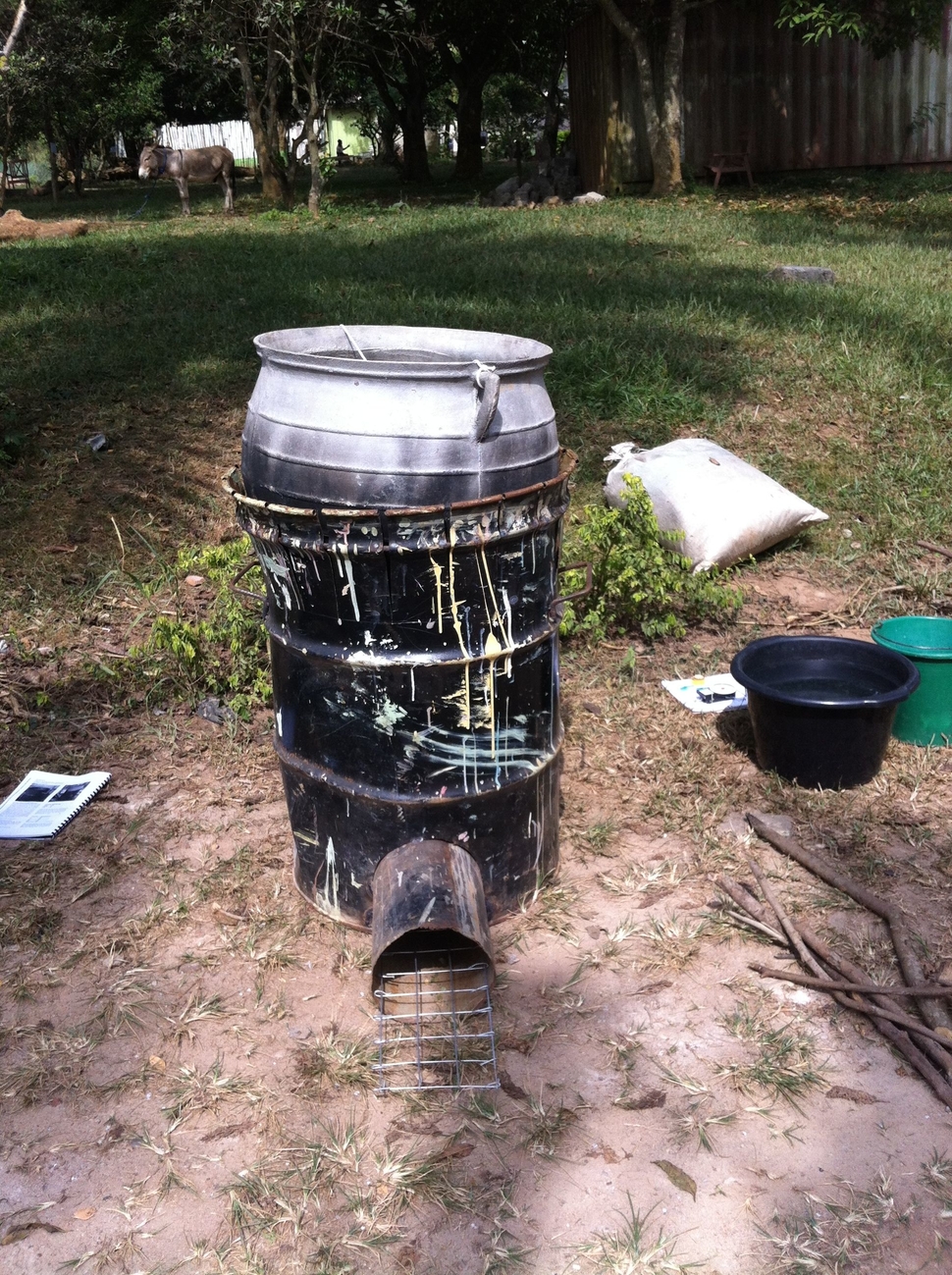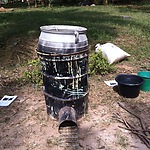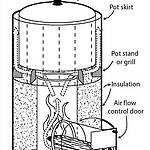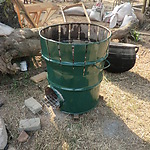First prototype
Choice of materials
For the first prototype we decided to make a combustion chamber out of metal instead
of clay. This was done because of the fact that the construction is much faster, the construction
costs are less and old barrels can be used, which makes it sustainable.
Rocket Stove based design
The design for the first prototype was based on the rocket stove design (see the picture
above). The cookstove consists out of a combustion chamber, a wood inlet and a large
barrel that is used as the outer case of the cookstove. No chimney was added to the
design because when the chimney is placed lower than the pot, it would only cause
heat losses. In order to make a sufficient airflow the prototype is designed in such a way that the area through which the air flows is the same everywhere the air should
flow. All the main parts can be made out of old paint barrels. However, it is important
that the barrel used for the construction of the combustion chamber is clean. Otherwise,
the remains of the paint will burn when the fire is burning inside the combustion
chamber and thus it will release toxic smoke. This prototype was designed for a pot
with a radius of 30 cm.
The combustion chamber
For the combustion chamber a diameter of 20 cm and a height of 60 cm was chosen.
From ‘Design principles for wood burning cook stoves’ (Bryden, M., e.a.) it was concluded
that a combustion chamber with a diameter of 20 cm would be sufficient for kenkey
makers. In the same document it states that the height of the combustion chamber
should be three times the diameter. The diameter of the wood inlet should be the same
as the combustion chamber, thus 20 cm. The length was chosen to be 27 cm. This way
it is possible to make two combustion chambers and two wood inlets out of one clean
barrel.
The outer barrel
The pot will be placed partly in the outer barrel. Where the pot is placed the diameter
of the outer barrel has to be 63 cm, in order to keep the area through which the air
flows the same size everywhere. To increase the diameter, eighteen cuts are made in
the barrel and the eighteen flaps are bend outwards. The grid is placed where the flaps
begin and the grid should be placed 4 cm above the combustion chamber. The total
height of the barrel is 87 cm, so the flaps will have a height of 24 cm.
The space between the combustion chamber and the outer barrel is filled with insulating
material. For the prototype a mix of ash and rice husk was used.
Grids
The grid is made out of iron rod; a ring with a diameter of 58 cm and four pieces of iron
rod with a length of 49 cm. A second ring of iron rod is placed at the top of the flaps in
order to strengthen the cookstove and to make sure the barrel will have the right diameter.
This ring has a diameter of 63 cm. Two handles can be made from the remaining
parts of the iron rod.
Second prototype
The second prototype is comparable with the first prototype, only a few adjustments
to the design are made. These adjustments will all be explained below.
The combustion chamber
The combustion chamber and the wood inlet are both made shorter and wider. The
new length was 40 cm and the increased diameter was 25 cm. The length was chosen
to be 40 cm, because this height is more suitable for cooking. The first prototype was
too high to cook kenkey on. The diameter is increased, because it turned out that the
wood inlet was too narrow.
The outer barrel
The outer barrel is also shortened. The top 9 cm are cut off and the slits between the
flaps have a depth of 34 cm. A third ring was added on top of the cookstove. So now
there are three rings, two with a circumference of 2 m on both the top of the barrel
and 20 cm under the upper ring and one with a circumference of 1,78 m at a height of
44 cm above the ground. The last ring will make the grid. In the second design the grid
is removable. A cover for the insulation materials is made out of the top of the barrel.
Stability
Lastly four iron bars are added as a stand. These bars have a height of 5 cm and a length
of 10 cm. These dimensions can differ a little if another bar is available. The stand will
make the cookstove more stable and will allow air to flow underneath the fire.
The building manual can be found in Appendix A.



